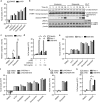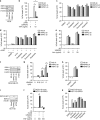Differential roles of RIPK1 and RIPK3 in TNF-induced necroptosis and chemotherapeutic agent-induced cell death
- PMID: 25675296
- PMCID: PMC4669795
- DOI: 10.1038/cddis.2015.16
Differential roles of RIPK1 and RIPK3 in TNF-induced necroptosis and chemotherapeutic agent-induced cell death
Abstract
Apoptosis is a key mechanism for metazoans to eliminate unwanted cells. Resistance to apoptosis is a hallmark of many cancer cells and a major roadblock to traditional chemotherapy. Recent evidence indicates that inhibition of caspase-dependent apoptosis sensitizes many cancer cells to a form of non-apoptotic cell death termed necroptosis. This has led to widespread interest in exploring necroptosis as an alternative strategy for anti-cancer therapy. Here we show that in human colon cancer tissues, the expression of the essential necroptosis adaptors receptor interacting protein kinase (RIPK)1 and RIPK3 is significantly decreased compared with adjacent normal colon tissues. The expression of RIPK1 and RIPK3 was suppressed by hypoxia, but not by epigenetic DNA modification. To explore the role of necroptosis in chemotherapy-induced cell death, we used inhibitors of RIPK1 or RIPK3 kinase activity, and modulated their expression in colon cancer cell lines using short hairpin RNAs. We found that RIPK1 and RIPK3 were largely dispensable for classical chemotherapy-induced cell death. Caspase inhibitor and/or second mitochondria-derived activator of caspase mimetic, which sensitize cells to RIPK1- and RIPK3-dependent necroptosis downstream of tumor necrosis factor receptor-like death receptors, also did not alter the response of cancer cells to chemotherapeutic agents. In contrast to the RIPKs, we found that cathepsins are partially responsible for doxorubicin or etoposide-induced cell death. Taken together, these results indicate that traditional chemotherapeutic agents are not efficient inducers of necroptosis and that more potent pathway-specific drugs are required to fully harness the power of necroptosis in anti-cancer therapy.
Conflict of interest statement
JB and PJ are employees of GlaxoSmithKline. All other authors declare no potential conflict of interest.
Figures






Similar articles
-
Key necroptotic proteins are required for Smac mimetic-mediated sensitization of cholangiocarcinoma cells to TNF-α and chemotherapeutic gemcitabine-induced necroptosis.PLoS One. 2020 Jan 8;15(1):e0227454. doi: 10.1371/journal.pone.0227454. eCollection 2020. PLoS One. 2020. PMID: 31914150 Free PMC article.
-
RIPK1 can function as an inhibitor rather than an initiator of RIPK3-dependent necroptosis.FEBS J. 2014 Nov;281(21):4921-34. doi: 10.1111/febs.13034. Epub 2014 Oct 4. FEBS J. 2014. PMID: 25195660
-
Activity of protein kinase RIPK3 determines whether cells die by necroptosis or apoptosis.Science. 2014 Mar 21;343(6177):1357-60. doi: 10.1126/science.1249361. Epub 2014 Feb 20. Science. 2014. PMID: 24557836
-
RIPK1 and RIPK3: critical regulators of inflammation and cell death.Trends Cell Biol. 2015 Jun;25(6):347-53. doi: 10.1016/j.tcb.2015.01.001. Epub 2015 Feb 4. Trends Cell Biol. 2015. PMID: 25662614 Review.
-
Necroptosis and Inflammation.Annu Rev Biochem. 2016 Jun 2;85:743-63. doi: 10.1146/annurev-biochem-060815-014830. Epub 2016 Feb 8. Annu Rev Biochem. 2016. PMID: 26865533 Review.
Cited by
-
Approaches to Evaluating Necroptosis in Virus-Infected Cells.Subcell Biochem. 2023;106:37-75. doi: 10.1007/978-3-031-40086-5_2. Subcell Biochem. 2023. PMID: 38159223
-
Exploring and validating the necroptotic gene regulation and related lncRNA mechanisms in colon adenocarcinoma based on multi-dimensional data.Sci Rep. 2024 Sep 27;14(1):22251. doi: 10.1038/s41598-024-73168-3. Sci Rep. 2024. PMID: 39333335 Free PMC article.
-
Characterizing the prognostic and therapeutic value of necroptosis in sarcoma based on necroptosis subtypes.Front Genet. 2022 Sep 27;13:980209. doi: 10.3389/fgene.2022.980209. eCollection 2022. Front Genet. 2022. PMID: 36238158 Free PMC article.
-
The Role of Programmed Necrosis in Colorectal Cancer.Cancers (Basel). 2022 Sep 1;14(17):4295. doi: 10.3390/cancers14174295. Cancers (Basel). 2022. PMID: 36077828 Free PMC article. Review.
-
Targeting cell death pathways for cancer therapy: recent developments in necroptosis, pyroptosis, ferroptosis, and cuproptosis research.J Hematol Oncol. 2022 Dec 8;15(1):174. doi: 10.1186/s13045-022-01392-3. J Hematol Oncol. 2022. PMID: 36482419 Free PMC article. Review.
References
-
- 1Hanahan D, Weinberg RA. Hallmarks of cancer: the next generation. Cell 2011; 144: 646–674. - PubMed
-
- 2Alison MR, Lin WR, Lim SM, Nicholson LJ. Cancer stem cells: in the line of fire. Cancer Treat Rev 2012; 38: 589–598. - PubMed
-
- 3Kroemer G, Galluzzi L, Kepp O, Zitvogel L. Immunogenic cell death in cancer therapy. Annu Rev Immunol 2013; 31: 51–72. - PubMed
Publication types
MeSH terms
Substances
Grants and funding
LinkOut - more resources
Full Text Sources
Other Literature Sources
Miscellaneous

